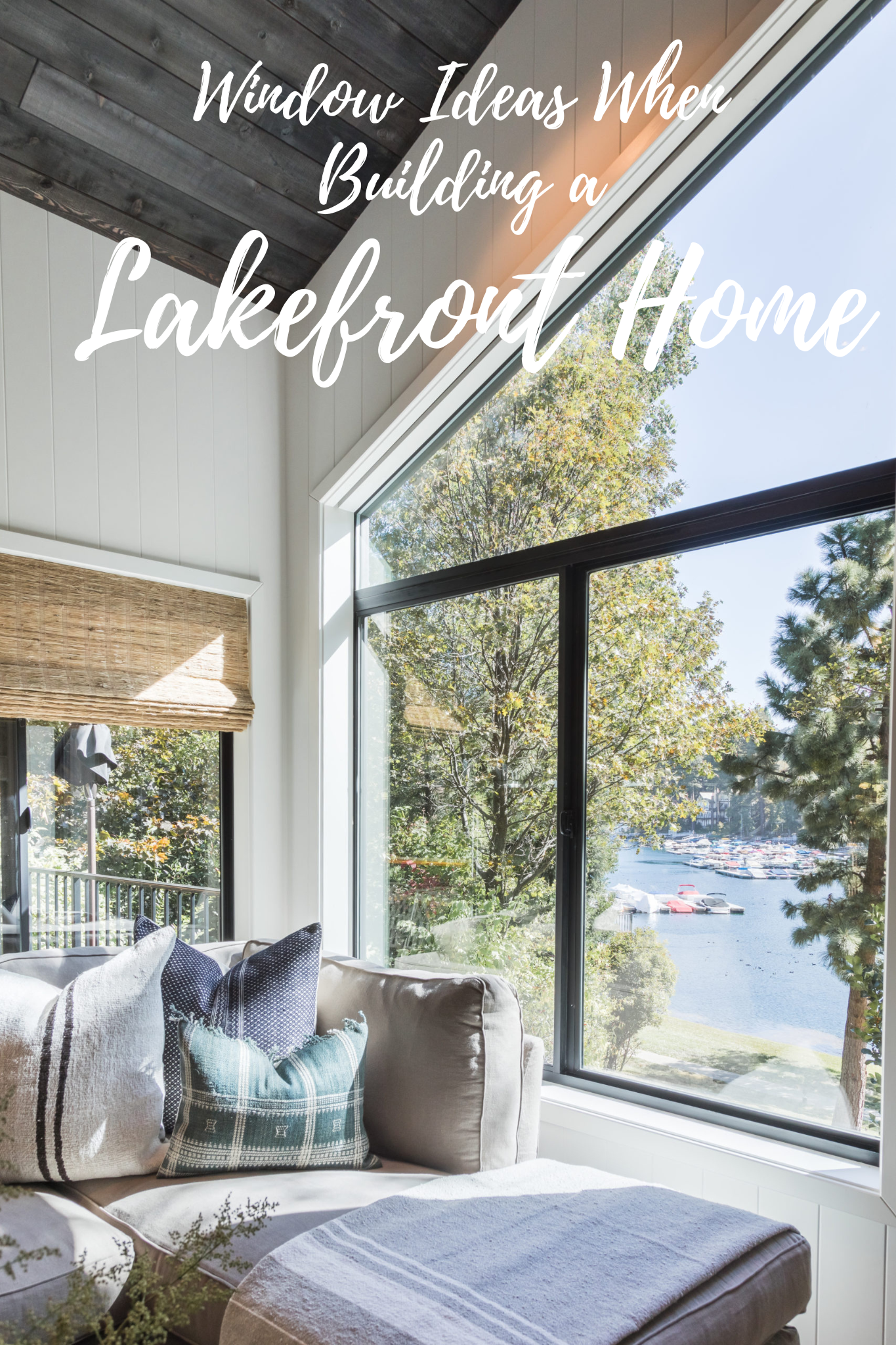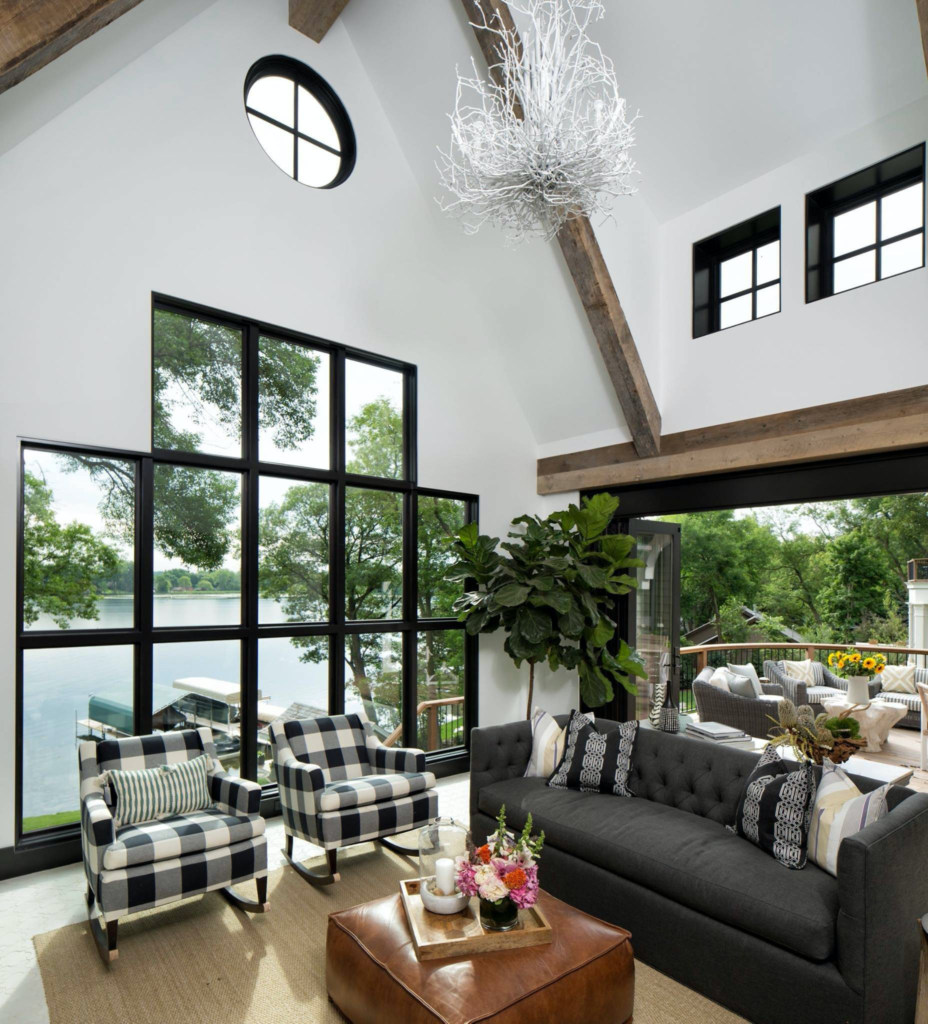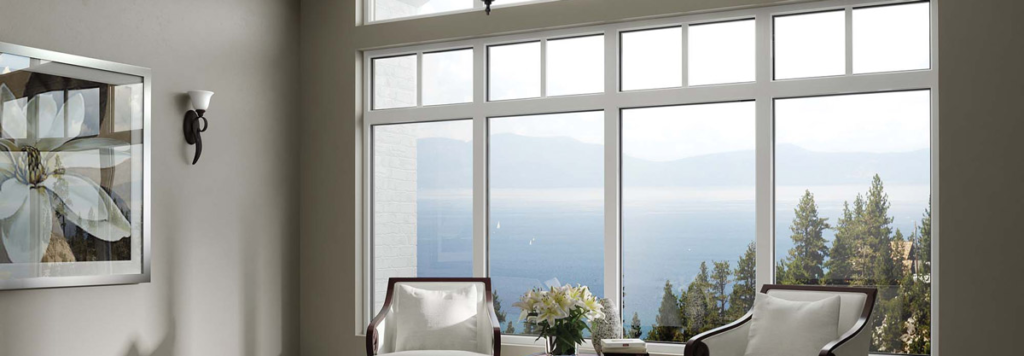
It’s all about the view with a lakefront home! People are eager to let the outside indoors when they’re surrounded by breathtaking views and glass is the perfect way to make a house feel like it’s barely there.
When you open up space with a lot of glass, it’s important to use quality products that will keep the home insulated and draft-free during the winter, and prevent the house from becoming a greenhouse in the summer by conducting heat. Smart glass products reduce energy consumption, a feature that adds lasting value for homebuyers looking to save on their hydro bills and reduce their carbon footprints.
Style-
Whether you are beginning a major renovation or new construction project, one of the main decisions you will make is the style or type of window you would like throughout your home. The four most basic and popular types are:

Single or Double Hung Windows
These are among the most common windows and are found in most homes. They consist of two separate sashes (the actual pane of glass in the inner frame), which open or close by sliding up or down. A single hung window opens from the bottom only by sliding up, while a double hung window can be opened from either the top or the bottom. Double hung windows are ideal for creating air flow through the home when you lower the top sash. They are especially suited to homes where there are small children as they prevent the danger of a child climbing out the bottom window. (Remember: window screens don’t support the weight of a small child.)
Casement Windows
These windows usually consist of one large sash that’s hinged vertically and opens by swinging out. Usually a lever or other mechanism is used to open this style of window.
Awning Windows

These windows are hinged at the top and opened by tilting the window out from the bottom. As their name suggests, awning window create the appearance of an awning when open. These windows are most popular in coastal areas and are often found in bathrooms.
Slider Windows
These windows slide open from side to side and are an excellent choice when there is limited space outside to swing the window open.
Once you determine the style of window for your home, you will need to select the type of material the windows are made of, or the frame.
Frames-
Aluminum Clad
Aluminum clad frames are very popular and can be practical in rainy and humid climates because they meet strict coastal building codes in hurricane-prone areas thanks to their strength. The tensile strength (measurement of maximum stress it can take before failure) of an aluminum clad window is about 8 times greater than a vinyl frame and similar to the strength of a fiberglass frame. Aluminum clad frames are similar to fiberglass frames in strength and durability but with approximately a 10% cost savings. Although they are strong, most aluminum clad window frames are not very energy efficient because they conduct heat. There are thermally broken aluminum clad windows that perform better but you need to look into the construction details. Most aluminum frames conducts heat easily, earning them a high U-value. (Higher is not better here — the higher the U-value, the more heat a frame loses.) Compared with vinyl or wood frames, which fall within the 0.3 to 0.5 range, aluminum frames can have a U-value as high as 2. They can be prone to condensation and as a result, the finish has about a 10-15 year lifespan before corrosion sets in and the finish begins to deteriorate. Because of the lack of longevity in the finish of an aluminum-clad frame, we do not recommend these windows to our clients. As with any aluminum product, repeated exposure to the moisture and salt results in the finish degrading over time. Usually, within 10-12 years, you will see corrosion on aluminum clad products. This is not a structural concern (not in this time period), but affects the aesthetic of the product.
Fiberglass

Fiberglass frames are the newest type of frames on the market and offer a strong, maintenance-free and energy efficient frame well suited for homes on the coast. More expensive than vinyl, but less expensive that wood frames, fiberglass frames offer a stylish and durable alternative. Fiberglass frames were developed to address the limitations of wood and vinyl products such as longevity and strength. Fiberglass frames are stronger than vinyl and don’t lose resiliency as they age. They have a more rigid frame and do not warp (ever!) and are highly resistant to rot and insects. They are also more energy efficient at about 1/8 the size of vinyl counterparts, with smaller frames and a lower profile, resulting in a less bulky and more streamlined appearance. Fiberglass frames are more resistant to environmental fading as the finish is inherent in the exterior. The interior of the fiberglass frame is usually wood and therefore can be painted to match any interior style. Fiberglass can be textured so that they closely resemble the look and feel of natural wood if desired.
Fiberglass windows can be more expensive than insulated vinyl windows, by as much as 100%, depending on the manufacturer.
Vinyl
A vinyl frame is typically the least expensive option and is commonly chosen by clients in our coastal region. A vinyl frame window can run as much as 50% less than a comparable wood frame version. With their good moisture resistance and low-maintenance finish, vinyl windows are an excellent choice for homes built on the coast. They are energy efficient and many are built using a honeycomb structure that traps air to improve it’s R-Value (thermal resistance; the higher an R-value, the better it insulates from heat and cold). They can be fabricated to fit any size opening. Because they are not painted, the exterior finish holds up very well over time.
Lighter colors absorb less heat than dark colors which seems to make their color stay true even longer. As vinyl ages, it loses some of its resiliency. A drawback of choosing vinyl is the limited color options available when compared to aluminum or wood (which can be painted). We do not recommend painting a vinyl product.
Wood / Wood-Clad
New window frames made of wood are quite popular and very energy efficient. They are easy to repair and maintain and can be painted to match interior selections. However, they are susceptible to rot and insect damage, and they tend to cost more. For traditionalists, they offer the best look for both inside and outside your home, but require greater maintenance and upkeep. We do not recommend using solid wood windows in our coastal environment.
Glass-
While the material of the window frame itself is important, it’s what inside that counts most.

After selecting the frame, the type of glass must be selected. Recent advancements in technology have greatly expanded the choices available in window glass. Besides choosing between double-, triple- or even quadruple-pane glass; you must also decide on the distance between the panes. The number of panes of glass doesn’t increase the insulation factor of the window, rather it’s the air between the panes of glass that provides the additional insulation. Most manufacturers today use an inert gas (usually argon) between the panes that insulates better than air alone.
Low Emissivity (Low-E) Glass: Low-E glass refers to glass with a special microscopically thin, virtually invisible layer of material on the surface of the glass which acts to reduce the amount of heat that can flow through the glass itself.
Impact Resistant Glass: If you hit this glass with a baseball bat it may crack, but it will not shatter and spread glass shards all over the place. The beauty of impact resistant glass is that under extreme weather conditions it holds up beautifully. And of course the occasional stray baseball won’t leave you with a big mess to clean up.
Impact rated window openings are required in homes on the coast. This leaves client with two options: 1) Install windows with impact rated glass in them, or 2) Install DP-50 windows without impact glass and add storm protection to the opening to meet impact resistance rating. We recommend the first option as most of the secondary systems that you install usually cancel out the cost savings from choosing non-impact glass. You also needn’t worry about installing plywood panels and shuttering up when a storm approaches if you choose impact glass.
Impact rated windows are specially designed with thicker glass, upgraded frames, and hardware that is sealed with one of the strongest adhesives on the market. All impact windows should have a minimum design pressure 50 psf rating, or the amount of pressure per square foot a window can sustain. In order to quantify this rating, the windows must go through rigorous design pressure test to ensure the windows can hold up to dangerous storm conditions. Typically this test is a three-pronged test that is based on the structural components, air, and water pressure. What does define the pressure rating of the window are the water penetration and structural test. Water penetration is tested by a percentage of the design pressure. The amount of rain that should be kept out is based on the windows DP rating. So in other words, a window with a DP 50 is tested at 7.5 psf. The structural test is primarily about the glass and the frame of the window. A way in which the window gets a higher DP rating is if the glass is thicker and the hardware is made with higher-end material. When a window is tested it is actually tested at a much higher pressure than what the pressure level indicates. For example, a window with a DP50 is rated to take the equivalent of 170mph wind.
Impact resistance is tested by firing a 2×4 missile at the window and evaluating how well it then holds up to pressure cycling — a test that is intended to simulate the forces of wind-borne debris striking the window during a hurricane. An impact-resistant window typically shatters during an impact test but maintains its integrity if the interlayer and glass shards hold together. This means an impact rated window might break but it will keep water from entering the home as well as keeping the home and occupants safe.
Additionally, here are a few important things to consider from the Department of Energy regarding the selection process for new windows:
·Look for the ENERGY STAR and NFRC labels.
·In colder climates, consider selecting gas-filled windows with low-e coatings to reduce heat loss. In warmer climates, select windows with coatings to reduce heat gain.
·Choose a low U-factor for better thermal resistance in colder climates; the U-factor is the rate at which a window conducts non-solar heat flow.
·Look for a low solar heat gain coefficient (SHGC). SHGC is a measure of solar radiation admitted through a window. Low SHGCs reduce heat gain in warm climates.
·Select windows with both low U-factors and low SHGCs to maximize energy savings in temperate climates with both cold and hot seasons.
·Look for whole-unit U-factors and SHGCs, rather than center-of-glass U-factors and SHGCs. Whole-unit numbers more accurately reflect the energy performance of the entire product.
·Look for Low-E coatings on the glass. These coatings reflect heat inside your house and reflect UV rays from the sun outside your home. They have a slight tint that may or may not be visible depending on how dark you want the tint to be. In colder climates, the coating is applied to the inside panes of glass, while in warmer climates, the coating is applied to the outside of the glass.
·Casement and awning windows are the most energy efficient because they clamp more tightly against the weather stripping on the frame than double-hung windows.
·Look for windows with multiple panes of glass separated by low-conductive argon or krypton gas filling and warm edge spacers with tightly constructed frames.
·The best weather stripping on any kind of operative window is a compressible gasket type much like you would find on your car doors. The weather stripping combined with a quality latch will effectively keep out cold air and rain, plus keep warm air in in winter.
·Look for windows with low U-values or U-factors. These windows have the best insulating properties.
If you are building or renovating a home on a lake, it is important to remember that not all windows are created equal when it comes to providing the right kind of protection against wind, rain, sun and hurricane or storm-related damage. Engaging a qualified and knowledgeable builder or window dealer can help you sort through the volume of available options as well as understand the more technical aspects of window performance ratings and building codes. Choosing the right windows will transform your home and let the tranquility of the lake inside.
Posted by Scott Freerksen “The Lake Guy”
